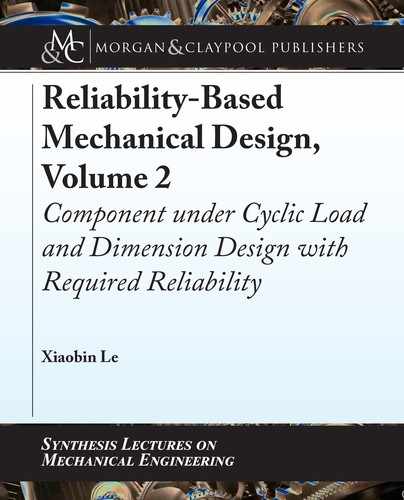
2.9. THE PROBABILISTIC FATIGUE DAMAGE THEORY (THE K-D MODEL) 77
Table 2.34: e equivalent stress amplitude and the average of ln.N /
Stress
level # i
σ
a
(ksi) σ
m
(ksi)
Number of
tests (J)
Equivalent
stress σ
ai
(ksi)
ln
(σ
ai
)
ln
(N
i
)
1 20.833 20.833 50 35.12623 3.558948 11.4736
2 22.083 22.083 55 38.83228 3.659252 11.0410
3 22.5 22.5 30 40.13937 3.692358 10.9551
4 22.917 22.917 30 41.48497 3.725331 10.7831
5 23.333 23.333 30 42.87081 3.758191 10.716
11.6
11.5
11.4
11.3
11.2
11.1
11
10.9
10.8
10.7
10.6
3.5 3.55 3.6 3.65 3.7 3.75 3.8
y = -3.8812x + 25.272
R
2
= 0.9914
ln (N)
ln (σa)
Figure 2.16: e traditional S-N curve.
(3) e histogram.
e histogram of K
0
with a total of 195 sampling data is displayed in Figure 2.17. From
the histogram shown in Figure 2.17, the material fatigue strength index K
0
seems to be a log-
normally distributed random variable.
(4) Type of distribution and its distribution parameters.
Following the procedure discussed in Section 2.13.3 of Le [8], we can create the MAT-
LAB program to run the Chi-square (
2
) goodness-of-fit test. e test result proves that the
material fatigue strength index K
0
in this example can be described by a lognormal distribution.
e three distribution parameters for the material fatigue strength index K
0
of this example are
listed in Table 2.35.

78 2. RELIABILITY OF A COMPONENT UNDER CYCLIC LOAD
11.6
11.5
11.4
11.3
11.2
11.1
11
10.9
10.8
10.7
10.6
3.5 3.55 3.6 3.65 3.7 3.75 3.8
y = -3.8812x + 25.272
R
2
= 0.99139
ln (N)
ln (sa)
Figure 2.17: e histogram of K
0
with a sampling size 195.
Table 2.35: K
0
with three distribution parameters
Material: 6061-T6
10-Gauge Sheet
Sample Size:
195
Test Conditions: Cyclic Axial Stress, Milled Machined
Sheet-type Flat Specimen
The Slope of the
Traditional S-N Curve: m
The Log-normally Distributed K
0
The Log Mean: μ
lnK
0
The Log Standard Deviation: σ
lnK
0
3.8812 25.3014 0.245451
2.9.3 THE COMPONENT FATIGUE STRENGTH INDEX K
As we have discussed in Section 2.4, we will use the Marin modification factors to consider
the differences between material fatigue specimen and component. After the differences are
considered, we can obtain the component fatigue strength index K.
e component fatigue strength index K is a mechanical property of a component and is ob-
tained through modifying the material fatigue strength index K
0
by the Martin modification
factors per Equation (2.79), and can be used to indirectly represent the component fatigue resis-
tance to the fatigue damage or the component fatigue strength. e component fatigue strength
index K can be determined by the following equation:
K D N
i
.
k
a
k
b
k
c
ai
/
m
D
.
k
a
k
b
k
c
/
m
N
i
.
ai
/
m
D
.
k
a
k
b
k
c
/
m
K
0
; (2.79)
where k
a
is the surface finish modification factor. k
b
is the size modification factor. k
c
is the
loading modification factor. ese Martin modification factors and its calculations have been
discussed in Section 2.3. m is the slope of the traditional S-N curve and can be determined
by Equation (2.74). K
0
is the material fatigue strength index and can be determined by Equa-
tion (2.73).
..................Content has been hidden....................
You can't read the all page of ebook, please click here login for view all page.
